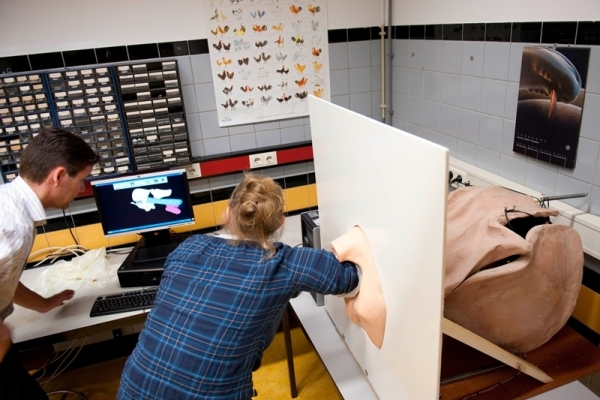Refinement in veterinary education: the Sensa Cow
10 years agoIn veterinary practices, checking the health or pregnancy status of farm animals is important to make a diagnosis in order to take appropriate medical interventions. Therefore, farm animals are used in veterinary education to practice different techniques to determine the health or pregnancy status of the animal.
In cows, the most common method used in this respect is the palpation technique per rectum. Students at the Faculty of Veterinary Medicine need to get training to accomplish this technique, which is considered very difficult because of the student’s inexperience of working with living animals and because of the inability to see the three-dimensional structure of the reproductive tract during palpating. The Faculty of Veterinary Medicine came up with a solution by developing a model to help the students with this difficult palpating technique: the Sensa Cow. The Sensa Cow is a model of a cow’s pelvis (see picture), implemented in education by project leader Dr. Claudia Wolschrijn, Associate Professor of the Department of Pathobiology, Faculty of Veterinary Medicine, Utrecht University.
Development and implementation of the Sensa Cow
The Sensa Cow exists of silicon organs with pressure sensors in connection with a computer screen, which offers students a simulation-based experience of the location of the organs, visualized with specific software on the computer screen. Students learn to find the reproductive organs more easily because they cannot only feel but actually see the organs live on the screen, that makes it easier to memorize the three-dimensional structure of the reproductive tract.
Dr. Wolschrijn: “The Sensa Cow has been developed in-house (at the Department of Pathobiology) in collaboration with master students of the Dutch School of Arts, the local Department of Physics and artist Remie Bakker. Pressure sensors were delivered by the Physics Department and the students were responsible for the processing of the sensory information by choosing the right hardware and software installments. Dutch artist Remie Bakker has developed the silicon organs’’.
The Sensa Cow model has been implemented and validated by a Project Grant from ZonMW (the Netherlands Organisation for Health Research and Development) called “Dierproeven begrensd”, in the period from 2009 till 2011. Nowadays, five Sensa-Cow models are present at the Faculty of Veterinary Medicine, among which two in the study landscape (of which one is pregnant), where students can practice on.
Refinement and reduction?
The pilot study elucidated that practicing with the Sensa Cow led to shorter rectal exploration times in the living cow. Students that were given the opportunity to practice first only needed 24 seconds to find the right reproductive organs in the living cow, compared to the duration of 166 seconds for the other group of students that did not practice. These results are promising in minimizing possible pain or discomfort of the cow during palpating and therefore leading to refinement of animal use.
And what about the reduction of animal use? “I don’t really believe we are reducing the number of cows in educating students, because we still use the animals before we allow students to go into the field and work with patients. However, refinement is maybe even more important in this area of clinical research”, says Claudia.
Two-fold advantage
The Sensa Cow has not only an important contribution to the refinement of the use of cows in education, but has a great impact as well on the quality of palpating techniques of veterinary students. Each year around 200 last year’s Bachelor students get acquainted with the Sensa Cow for the first time, as one of the initial steps in becoming a successful veterinarian. Before the Sensa Cow was introduced in education, some students experienced difficulties when they started practicing immediately in the living cow. Currently, they still need to practice in living cows of course, but not before they are trained well with the Sensa Cow. Claudia: “Me and the other lecturers were wondering how we could help the students to learn the difficult palpating technique better and to make the steps towards palpating a living cow smaller. Some students are anxious to start working immediately in the living cow. This is why we invented the Sensa Cow. And it works, students are more self-confident and ready to work with living cows and the patients eventually”.
So this is something the Faculty of Veterinary Medicine can be proud of: they are working on the enhancement of farm animal welfare ánd on the delivery of better veterinary professionals. Above this, the Sensa Cow goes beyond Dutch borders: “some international parties have shown interest as well”.
Source: 3Rs Centre ULS


